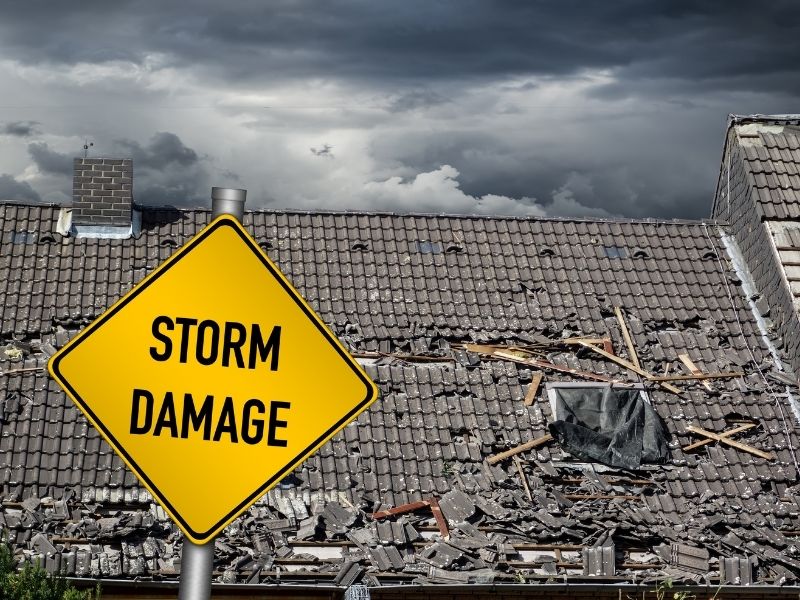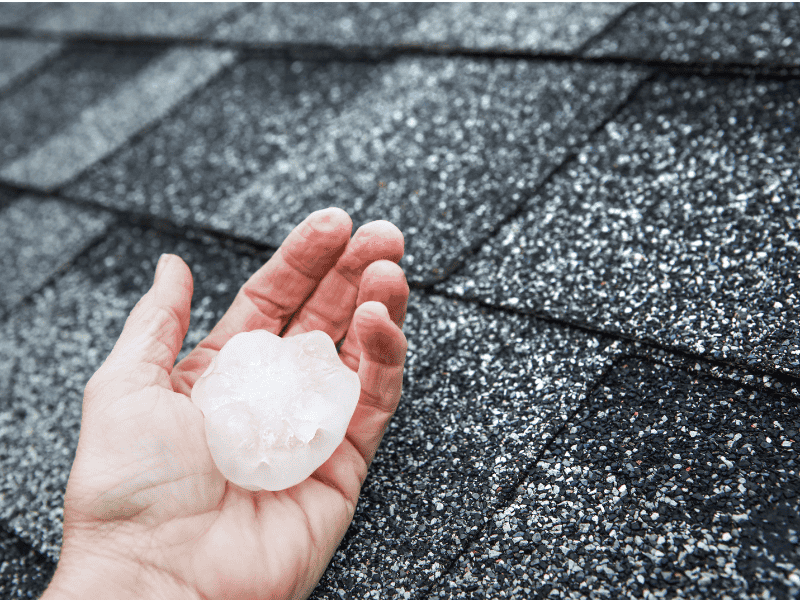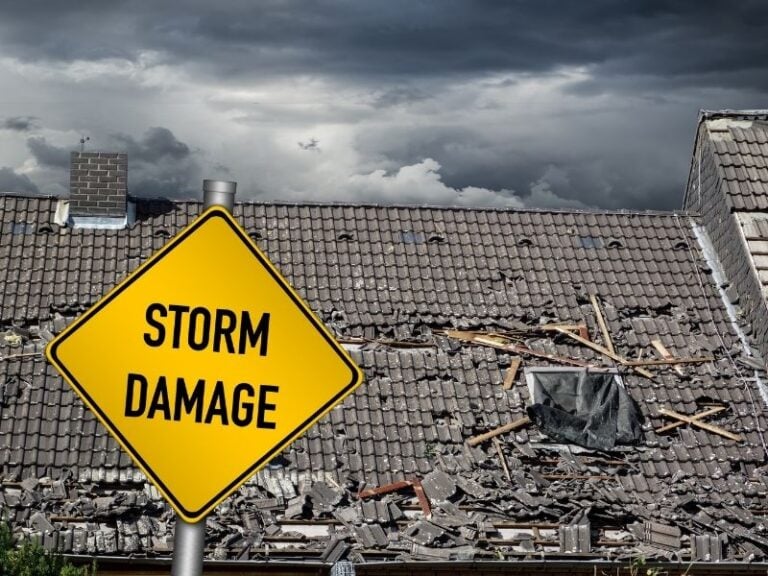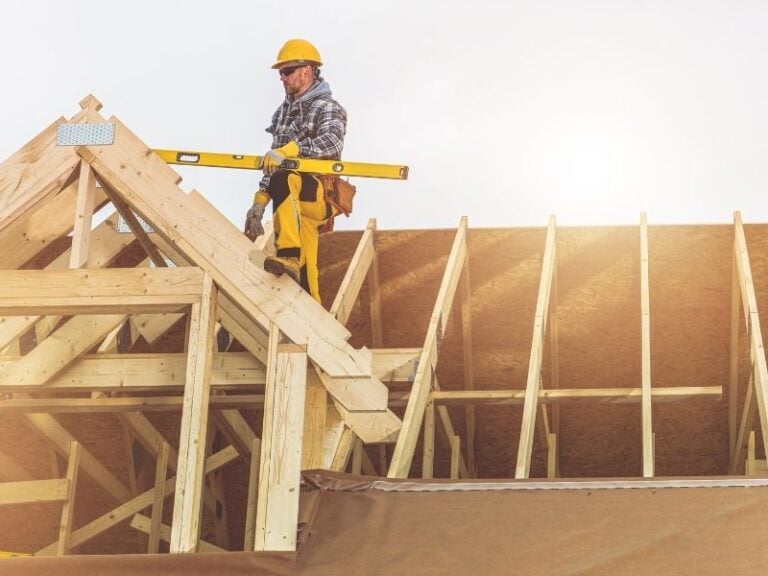Storm season in New York brings more than just thunder and lightning it leaves behind damage that often hides in plain sight. From intense nor’easters and lake-effect snowstorms to summer thunderstorms and ice storms, New York weather creates unique roofing challenges. While dramatic destruction like missing shingles or fallen tree limbs catches immediate attention, the most expensive problems lurk beneath the surface. Understanding what is considered storm damage to roof structures helps New York homeowners catch issues before they escalate into costly emergencies.
Many homeowners believe their roof survived a New York storm simply because they don’t see obvious damage from ground level. However, wind-driven rain from nor’easters can penetrate tiny openings, hail can crack protective granules without creating visible holes, and heavy snow loads can stress structural components. Ice dams, common throughout upstate New York, force water under shingles, and moisture can travel along roof decking before dripping onto your ceiling. By the time interior damage appears, significant deterioration has already occurred. This guide reveals the hidden warning signs specific to New York weather patterns that indicate what is considered storm damage to roof systems, helping you take action before minor issues become major disasters.

Key Takeaways
- Check your attic immediately after storms for water stains, wet insulation, or light penetrating through the roof deck
- Look for granule loss in gutters which indicates hail damage and compromised shingle protection
- Monitor interior warning signs including ceiling stains, musty odors, higher energy bills, and peeling paint
- Inspect shingles for subtle damage like lifted edges, creasing, or soft spots that aren’t visible from the ground
- Professional inspections catch hidden issues that untrained eyes miss, especially after significant weather events
- Document all damage immediately with photos and notes for insurance claims before conditions worsen
Overview
Storm damage to roofs in New York includes wind-torn shingles from nor’easters, hail impacts from severe thunderstorms, water infiltration from ice dams, and structural stress from heavy lake-effect snow or winter ice accumulation. What is considered storm damage to roof systems extends beyond visible destruction to include compromised granule protection, lifted flashing, cracked sealants, and moisture penetration into underlayment layers, all common issues in New York’s harsh climate.
Hidden damage often appears first inside your home through ceiling stains, attic moisture, mold growth, or unexplained energy cost increases during New York’s cold winters. Exterior signs include granules accumulating in gutters, subtle shingle creasing, dented vents and flashing, ice dam indicators, or dark streaks showing water paths.
Professional inspections reveal damage invisible to homeowners: micro-cracks in shingles from freeze-thaw cycles, compromised adhesive seals, deteriorated flashing, saturated insulation, and early wood rot in structural components. Acting quickly prevents small problems from requiring complete roof replacement.
Understanding What Storm Damage Actually Means in New York
What is considered storm damage to roof structures in New York encompasses a wide range of issues caused by the state’s diverse and severe weather events. Nor’easters, lake-effect snow, ice storms, summer thunderstorms, wind, hail, heavy rain, and flying debris all create distinct damage patterns. Recognizing these patterns helps you identify problems before they worsen.
Common types of New York storm damage include:
- Missing, torn, or lifted shingles from high winds and nor’easters
- Granule loss and impact dents from hail during severe thunderstorms
- Ice dam damage forcing water under shingles during winter
- Compromised flashing around chimneys, vents, and skylights
- Water infiltration through damaged underlayment
- Structural stress from heavy lake-effect snow or ice accumulation (upstate New York regularly sees 100+ inches of snow annually)
- Punctures or cracks from fallen branches and debris
Wind damage from nor’easters often appears subtle initially. These powerful coastal storms generate sustained winds of 40-60 mph with gusts exceeding 70 mph. Strong gusts lift shingle edges, breaking the waterproof seal between overlapping layers. This creates vulnerabilities where wind-driven rain penetrates. Over time, repeated lifting weakens shingle adhesion, leading to complete failure during subsequent storms.
New York’s freeze-thaw cycles compound wind damage. Water seeps under lifted shingles, freezes during cold nights, expands, then thaws, repeating this destructive cycle throughout winter and early spring. This accelerates shingle deterioration unique to northern climates.
Understanding what is considered storm damage to roof components in New York helps you communicate effectively with contractors and insurance adjusters during the claims process.
Hidden Interior Warning Signs You Shouldn’t Ignore
Your home’s interior often reveals storm damage before exterior symptoms become obvious. Water travels along rafters and roof decking before finally dripping through ceilings, making interior inspection critical after severe weather.
Ceiling stains appear as brown, yellow, or rust-colored discoloration, typically forming irregular shapes that darken after rain. These stains indicate active leaks allowing moisture into your home. Water may travel several feet from the actual breach point before appearing on ceilings, complicating leak location without professional help.
Musty odors signal moisture accumulation even without visible stains. Damp insulation and hidden mold growth create distinctive smells that warn of ongoing water infiltration. This odor intensifies in enclosed spaces like closets or rooms with poor ventilation.
Critical interior warning signs include:
- Water stains spreading across ceilings or upper walls
- Peeling or bubbling paint on ceiling surfaces
- Sagging drywall or ceiling sections
- Mold or mildew growth in attic spaces
- Unexplained spikes in heating or cooling costs
- Damp or compressed attic insulation
Rising energy bills often indicate what is considered storm damage to roof insulation and ventilation systems, a significant concern during New York’s harsh winters when heating costs spike. When moisture saturates insulation, it loses thermal resistance, forcing HVAC systems to work harder maintaining temperature. Additionally, roof breaches allow conditioned air to escape, further increasing energy consumption during long, cold New York winters.
Addressing interior warning signs quickly prevents mold proliferation, structural wood rot, and extensive drywall replacement. What seems like minor ceiling discoloration can indicate serious underlying damage requiring immediate professional attention especially critical before New York’s next harsh winter season.
Attic Inspection: Your First Line of Defense
Your attic provides the clearest view of what is considered storm damage to roof structures before problems reach living spaces below. Regular attic inspections catch issues early when repairs remain manageable and affordable.
Start by turning off attic lights on a sunny day. Light penetrating through the roof deck indicates breaches where shingles, underlayment, or flashing have failed. Even pinpoint light sources represent potential leak points during rain events. Mark these locations and have professionals assess from the exterior.
Examine insulation for moisture. Wet insulation appears darker, feels damp, and may show compression or displacement. Moisture destroys insulation’s effectiveness and promotes mold growth. Additionally, check for water stains on the underside of roof decking dark spots indicate previous or ongoing leaks.
Essential attic inspection points:
- Roof deck underside for water stains, dark spots, or ice dam damage
- Rafters and trusses for cracks, warping, sagging, or freeze-thaw damage
- Insulation condition and moisture content (critical for New York winters)
- Ventilation function and airflow adequacy (prevents ice dams)
- Flashing around chimneys, vents, and penetrations
- Evidence of pest entry through storm-created openings
Wood rot appears as darkened, softened timber that may crumble under pressure. Check rafters and trusses carefully, structural damage from what is considered storm damage to roof framing requires immediate intervention to prevent collapse, especially before heavy snow loads return to upstate New York.
Poor ventilation compounds storm damage by trapping moisture and contributes to ice dam formation, a major issue in New York’s cold climate. If your attic feels significantly hotter than outside temperatures or maintains high humidity, ventilation issues exist. This creates ideal conditions for mold growth and accelerates roof deterioration.
Schedule professional attic inspections annually and immediately following major storms. Experts identify subtle damage patterns that untrained observers miss.
Exterior Signs Visible From the Ground
Ground-level inspection reveals numerous indicators of what is considered storm damage to roof surfaces. Walk your property’s perimeter immediately after storms, documenting all observations with photos for insurance purposes.
Missing shingles represent obvious wind damage. However, also look for shingles lying in your yard, caught in landscaping, or scattered across driveways. These pieces provide evidence of storm damage even if gaps aren’t visible from ground level.
Granule accumulation in gutters and downspouts signals hail impact or advanced shingle deterioration. After storms, check gutters for excessive granule buildup appearing like coarse black sand. Small amounts of granule loss occur naturally over time, but sudden large quantities indicate what is considered storm damage to roof shingle protection.
Visible damage indicators include:
- Shingles missing from roof sections
- Curled, lifted, or creased shingle edges
- Dark streaks showing water runoff paths
- Dented or damaged gutters and downspouts
- Dents on metal roof vents or flashing
- Tree limbs resting on roof surfaces
Examine nearby structures for collateral damage. Dented siding, cracked windows, or damaged outdoor furniture suggest storm forces strong enough to harm your roof. Similarly, check neighboring roofs, if surrounding homes show damage, yours likely sustained similar impacts.
Use binoculars to examine your roof more closely from the ground. Look for shingles with lifted corners, horizontal creases indicating wind stress, or areas where shingle color appears different due to granule loss. However, avoid climbing onto wet or damaged roofs without professional safety equipment and training.
What is considered storm damage to roof components often includes subtle changes that only become apparent through careful observation and comparison to pre-storm conditions.

The Dangers of Hail Damage You Can’t See
Hail creates some of the most deceptive forms of what is considered storm damage to roof systems. While softball-sized hail leaves obvious destruction, pea-sized hailstones cause insidious damage that homeowners overlook until leaks develop months later.
Hail strikes shingles with tremendous force, cracking protective granules and bruising underlying asphalt. These impacts may not penetrate shingles immediately but compromise their integrity. Bruised spots feel soft when pressed, similar to bruises on fruit, and appear as dark circles on shingle surfaces.
Granule loss from hail exposure accelerates dramatically. Protective granules shield shingles from UV radiation and water absorption. Once granules disappear, asphalt deteriorates rapidly under sun exposure, becoming brittle and prone to cracking. Within months, previously functional shingles begin failing.
Hail damage characteristics:
- Soft spots or bruises on shingle surfaces
- Random pattern of impacts across the roof
- Granule loss creating shiny, exposed asphalt areas
- Dents on metal components like vents, flashing, and gutters
- Cracked or fractured shingle edges
- Impact marks on roof-mounted equipment
Insurance companies typically require professional documentation of what is considered storm damage to roof materials from hail. Adjusters look for impact patterns, granule displacement, and corroborating evidence like dented air conditioning units or outdoor fixtures. Most policies mandate claims within specific timeframes following hail events—missing deadlines means paying for repairs yourself.
Thermal imaging reveals hidden hail damage by detecting temperature variations where impacts compromise shingle layers. Professionals use this technology during inspections to identify damage invisible to visual examination.
Never assume your roof survived hailstorms without professional verification, especially if surrounding properties show damage or your insurance company reports significant hail in your area.
Wind Damage: More Than Missing Shingles in New York
Wind creates various forms of what is considered storm damage to roof structures beyond the obvious missing shingles, particularly from nor’easters and severe thunderstorms common throughout New York. Understanding wind damage patterns helps identify problems requiring immediate attention versus those needing monitoring.
Nor’easters generate sustained high winds that stress shingle adhesive seals. Even when shingles remain attached, repeated lifting and settling damages these seals. Subsequently, moderate winds that wouldn’t normally cause problems can tear away previously stressed shingles. New York typically experiences several nor’easters each winter, creating cumulative damage.
Horizontal creases across shingles indicate wind lifting. These lines show where wind got underneath shingles, bending them backward before releasing. Creased shingles have compromised waterproofing and will fail sooner than undamaged materials.
Wind damage indicators common in New York:
- Lifted shingle corners or edges from nor’easter winds
- Horizontal creasing across shingle surfaces
- Torn or ripped shingle sections
- Exposed underlayment or roof deck
- Displaced or damaged flashing
- Gaps in shingle overlap patterns
What is considered storm damage to roof edges often concentrates along eaves, rakes, and ridges where wind forces intensify, especially problematic during nor’easters and lake-effect wind events. These vulnerable areas deserve extra attention during post-storm inspections. Additionally, examine areas near roof penetrations like chimneys and vents where wind creates turbulence.
Damaged flashing around chimneys, skylights, and vent pipes creates leak pathways. Wind can loosen flashing, bend metal pieces, or tear sealant connections. Even small flashing failures allow significant water infiltration during New York’s frequent rain and snow events.
Professional wind damage assessment includes checking fastener pull-through, where wind forces pull nails through shingle material, and adhesive seal failure that isn’t visible without lifting shingle edges for inspection.
Water Infiltration and Its Long-Term Consequences in New York
Water infiltration represents perhaps the most destructive aspect of what is considered storm damage to roof systems, especially in New York where freeze-thaw cycles, ice dams, and nor’easters create multiple pathways for moisture entry. Unlike visible damage, water damage progresses silently, causing extensive harm before symptoms appear.
Storm-driven rain from nor’easters penetrates through the smallest openings. Wind forces water sideways and upward, defeating normal gravity-dependent drainage. This pressurized water finds paths through damaged shingles, compromised flashing, or deteriorated sealants. Ice dams, formed when heat escapes through inadequate insulation, melts roof snow, which then refreezes at cold eaves, trapping water behind them, forcing it under shingles and into homes. This phenomenon affects countless New York homes each winter.
Once water penetrates, it travels along roof decking and rafters following paths of least resistance. Moisture accumulates in insulation, saturates wood framing, and eventually reaches ceilings. This journey can span considerable distances, making leak sources difficult to locate.
Water damage progression includes:
- Initial penetration through storm-damaged areas or ice dams
- Migration along roof deck and structural members
- Insulation saturation and compression (reduces heating efficiency)
- Wood rot in rafters, trusses, and decking accelerated by freeze-thaw cycles
- Mold and mildew growth in dark, damp spaces
- Ceiling staining and eventual drywall failure
Mold develops within 24-48 hours in moist environments. Attic spaces with poor ventilation and wet insulation provide ideal conditions for rapid mold proliferation. Some mold species create health hazards requiring professional remediation beyond simple roof repair.
Wood rot compromises structural integrity. What is considered storm damage to roof framing includes moisture-induced deterioration that weakens load-bearing components, particularly dangerous when heavy New York snow loads stress already weakened structures. Advanced rot requires extensive repairs including framing replacement, dramatically increasing project costs compared to addressing initial leak sources.
Catching water infiltration early prevents these cascading failures. Any signs of moisture in attics or on ceilings warrant immediate professional inspection and repair.
Why Professional Inspections Are Essential
While homeowners can identify obvious damage, professionals detect subtle indicators of what is considered storm damage to roof systems that untrained observers miss. Their expertise and specialized equipment provide comprehensive assessments critical for proper repairs and insurance claims.
Professional roofers know where damage concentrates based on storm characteristics. They understand how wind patterns create stress concentration zones and recognize damage signatures specific to hail size, wind speed, or precipitation type. This knowledge guides thorough inspections of vulnerable areas.
Specialized tools enhance detection capabilities. Infrared cameras reveal temperature variations indicating moisture infiltration. Moisture meters measure water content in materials. Drones capture high-resolution imagery of roof surfaces without safety risks associated with climbing.
Professional inspection benefits include:
- Comprehensive damage documentation for insurance claims
- Detection of hidden structural issues
- Safety compliance during roof access
- Expert assessment of repair versus replacement needs
- Warranty validation for existing roofing systems
- Detailed written reports with photographic evidence
Insurance companies respect professional documentation of what is considered storm damage to roof components. Adjusters rely on contractor reports when determining claim validity and coverage amounts. DIY assessments carry less weight and may result in denied or reduced claims.
Timing matters critically. Many insurance policies require storm damage claims within specific timeframes, often 6-24 months following weather events. Professional inspections immediately after storms document damage before normal wear makes causation difficult to prove.
Additionally, professionals identify safety hazards like compromised structural integrity, loose materials threatening to fall, or electrical hazards from water infiltration near service equipment. They advise whether properties remain safe for occupancy or require immediate evacuation.
Taking Action: Next Steps After Finding Damage
Discovering what is considered storm damage to roof structures requires prompt, methodical response to minimize harm and maximize insurance recovery. Following proper procedures protects your home and your claim validity.
Document everything thoroughly before any repairs. Photograph all damage from multiple angles, including wide shots showing location context and close-ups revealing detail. Video walkthroughs provide comprehensive records. Date-stamp all documentation and save backup copies in multiple locations.
Immediate action steps:
- Contact your insurance company to report potential storm damage
- Schedule professional inspection for detailed assessment
- Make temporary repairs to prevent further damage (tarping, etc.)
- Keep all receipts for emergency repairs and mitigation
- Avoid permanent repairs until insurance adjuster inspects
- Maintain damaged materials as evidence for adjuster review
Temporary protection prevents additional damage while claims process. Insurance policies typically require reasonable mitigation efforts. Tarping damaged sections, placing buckets under active leaks, and moving valuables away from water qualify as appropriate temporary measures.
Review your insurance policy carefully. Understand deductibles, coverage limits, depreciation calculations, and claim filing deadlines. Many policies cover sudden storm damage but exclude gradual deterioration, making documentation of storm timing essential.
Choose contractors wisely. Avoid storm chasers who appear suddenly after weather events offering quick fixes. Instead, select licensed, insured, local contractors with established reputations. Verify credentials, check references, and obtain multiple estimates.
Understanding what is considered storm damage to roof systems helps you advocate effectively throughout the repair and claims process, preventing insurance companies from inappropriately denying legitimate damage.
Get Expert Storm Damage Assessment in New York Today
Don’t wait until hidden damage becomes an expensive emergency. If you suspect what is considered storm damage to roof structures on your New York property, professional evaluation provides peace of mind and protects your investment. Storm damage rarely improves on its own, early intervention prevents minor issues from requiring complete roof replacement, especially before New York’s next harsh winter.
Kornerstone Roofing specializes in thorough storm damage assessments throughout upstate New York. Our experienced team understands New York’s unique weather challenges from nor’easters and ice dams to lake-effect snow and severe thunderstorms. We identify hidden damage that homeowners and insurance adjusters often overlook, providing detailed documentation supporting your insurance claims. Located at 15 Wood Rd Unit 100, Round Lake, NY 12151, we’ve helped countless New York property owners recover from storm damage and restore their roofs to peak condition. Our comprehensive inspections reveal exactly what is considered storm damage to roof systems on your property, with transparent recommendations for necessary repairs. Call (518) 707-1795 today to schedule your professional storm damage inspection.
Conclusion
Hidden storm damage poses serious threats to your home’s integrity and your family’s safety, especially in New York where diverse weather patterns create multiple damage pathways. Understanding what is considered storm damage to roof structures helps you identify problems before they escalate into costly emergencies. From subtle interior warning signs like ceiling stains and musty odors to exterior indicators like granule loss and lifted shingles, recognizing these red flags enables timely intervention.
Professional inspections provide comprehensive assessments that untrained observers cannot match, particularly for damage unique to New York’s climate like ice dam impacts and freeze-thaw deterioration. Don’t gamble with your home’s protection, schedule professional evaluation after any significant weather event, especially before winter. What warning signs might your New York roof be showing right now that you’ve been ignoring?
FAQs
Q: What is considered storm damage to roof systems by insurance companies?
A: Insurance typically covers sudden damage from wind, hail, falling debris, and heavy precipitation. This includes torn or missing shingles, hail-induced granule loss, impact dents, compromised flashing, and water infiltration resulting from storm events. However, gradual deterioration, poor maintenance, or pre-existing conditions usually aren’t covered. Insurance adjusters look for damage patterns consistent with documented weather events and require claims within policy-specified timeframes.
Q: How soon after a storm should I inspect my roof for damage?
A: Inspect your roof within 24-48 hours after severe weather when it’s safe to do so. Immediate inspection allows you to document damage before conditions change and enables prompt temporary repairs preventing further harm. Most insurance policies require notification within specific timeframes, and early documentation strengthens claims. However, never access roofs during storms or when conditions remain dangerous.
Q: Can I spot storm damage from the ground, or must I climb onto my roof?
A: Many storm damage indicators appear from ground-level inspection including missing shingles, granules in gutters, dented components, and interior warning signs like ceiling stains. Binoculars enhance ground-based inspection. However, comprehensive assessment requires roof access to check shingle condition, flashing integrity, and subtle damage. Leave this to professionals with proper safety equipment and training.
Q: What’s the difference between wind damage and hail damage on roofs?
A: Wind damage typically appears as lifted, torn, or missing shingles with horizontal creasing and concentrated along roof edges. Hail damage shows random impact patterns including granule loss, soft bruised spots on shingles, and dents on metal components. Wind creates directional damage patterns while hail impacts randomly across all surfaces. Both require professional documentation for insurance claims.


